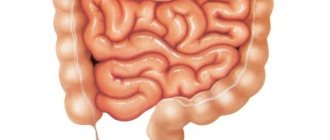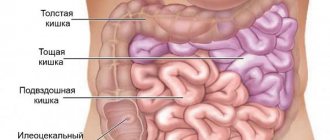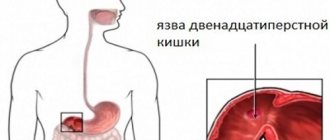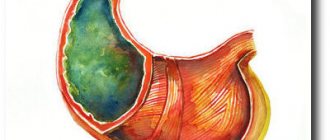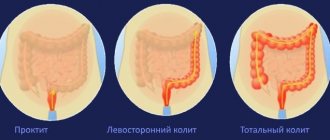When the intestinal walls are irritated, nerve endings are activated, which contributes to disruption of the tone of smooth muscle tissue. There is a failure in the rhythmic contraction of the intestine and peristalsis of a heterogeneous nature occurs, the evacuation activity of the intestine is disrupted. All causes of intestinal spasms are associated with these organ dysfunctions.
Intestinal spasm is a symptom of a huge number of diseases of the digestive tract, characterized by high-intensity visceral pain associated with significant contraction of the intestinal wall. The main symptom of intestinal colic is cramping pain, usually combined with other symptoms of the underlying disease. To determine the cause of this condition, various laboratory, x-ray, ultrasound and instrumental research methods may be required. Treatment of intestinal spasms is conservative: sedatives, antispasmodics, heat on the abdominal area, antidiarrheals and a special diet.
Spasm, translated from Greek as “convulsions”, “stretch”, is a convulsive contraction of muscle tissue, in which the relaxation process may not occur for a long time, or may occur after a certain period of fast, rhythmic muscle shocks. Known smooth muscle spasms in the gastrointestinal tract are:
- Cardiospasm is a spasm of the esophagus in the place that passes into the stomach.
- Pylorospasm is a contraction of the sphincter located in the stomach (pylorus) and separating it from the duodenum.
- Enterospasm is a spastic contraction of the small intestine.
Frequent spasms that occur in the smooth muscle structure of the intestine, popularly referred to as intestinal colic, can have a very adverse effect on the organ itself and be a separate pathological ailment and a symptom of many diseases, so you should not delay treatment. Under the influence of many negative factors, the intestinal walls become irritated and stimulate the transmission of nerve impulses that disrupt the tone of smooth muscles. Failures in the synchronized, peristaltic movement of the intestinal walls are accompanied by the occurrence of aching, sharp intestinal pain.
General information
Intestinal spasm is not an independent nosological entity, but only serves as a sign of serious problems in the gastrointestinal tract. Most often, this functional disorder of the intestines occurs in infancy, but adults often also complain of spasmodic abdominal pain.
The country's leading experts in the field of gastroenterology have been debating for many years whether to consider such functional disorders (gastroesophageal reflux, functional diarrhea, intestinal spasms, etc.) simply as a symptom of trouble in the digestive tract, or as a premorbid condition, which in the future can transform into an organic pathology.
There is currently no consensus on the status of functional disorders, but patients should take intestinal colic seriously. Finding out the cause of this condition means preventing the development of serious diseases of the gastrointestinal tract.
Types of pain
There are two main types of pain in the intestinal area:
- spastic pain (in other words, experts call it intestinal colic): due to increased gas formation or an inflammatory process, short-term discomfort may suddenly appear;
- constant pain: manifested by a slight burning and tingling sensation in the lower abdomen; this ailment in most cases occurs due to a chronic disease.
Along with this ailment, a number of accompanying symptoms may also appear: increased sweating, nausea or vomiting, diarrhea or constipation, mild chills. If there is a chronic disease, visual signs may appear, represented by darkening of the urine and the appearance of bloody clots in the stool.
Possible causes of night pain
In total, there are several causes of night pain in the abdomen and intestines:
- gastritis: this disease is an inflammation of the gastric mucosa, at first a person experiences a slight nagging pain, gradually it becomes acute, along with a feeling of heaviness and discomfort, appetite disappears, belching and vomiting appear;
- acid reflux: stomach acid enters the digestive system, causing a person to feel heartburn, a sore throat, and in some cases vomiting and a feeling of bloating;
- stomach or intestinal ulcer: with this disease, the pain is first periodic (intensifies after eating), and then it becomes constant;
- irritable bowel syndrome: experts attribute this ailment to the individual characteristics of the body; after eating, gas formation increases and bloating appears, which causes pain in the lower abdomen.
Pain is not always a sign of disease development. It can progress after eating a fatty meal or canned food. Along with this, constipation and a feeling of heaviness may occur.
Read: what is intestinal lavage.
We recommend finding out how the diffusely heterogeneous structure of the pancreas manifests itself.
Causes of intestinal spasm
Cramping pain, characteristic of intestinal spasm, can occur due to disturbances in various mechanisms of intestinal motility. The main links in the pathogenesis of intestinal spasm: overstretching of the intestinal wall, irritation of nerve endings, disturbance of the tone of the smooth muscles of the intestine with a disorder in the mechanisms of its contraction, the occurrence of pathological peristalsis (antiperistalsis, weakening or strengthening of peristaltic waves, disappearance of peristalsis in some parts of the intestine), the occurrence of an obstacle to promote the food bolus.
Intestinal spasms can occur against the background of digestive disorders - acute and chronic gastritis, stomach and duodenal ulcers, hepatitis, pancreatitis, etc. In case of disturbances in the digestion of food in the stomach and initial parts of the intestines, an untreated bolus of food enters the intestines and causes excessive irritation of its receptors, muscle spasm . Another common cause of intestinal spasms is errors in nutrition - the mechanism of development of colic is the same as with digestive disorders, but irritation of the intestinal wall occurs from too cold, spicy, fried, dry, stale food, products made from yeast dough, etc.
Intestinal colic can also develop due to intoxication - with generalized viral infections (influenza, ARVI), poisoning with industrial and plant poisons, salts of heavy metals. In these cases, intestinal spasm occurs due to the effects of poisons and toxins on the neuromuscular apparatus of the intestine. Intestinal infections can also be the cause of this pathology: the proliferation of bacteria in the intestinal lumen has a complex effect, causing irritation of nerve endings, excessive exudation with overstretching of the intestinal wall, and disturbances in peristalsis.
Asthenic people with a labile psyche, prone to strong emotions, often experience cramping abdominal pain associated with intestinal spasms during stressful situations. During emotional shocks, the autonomic regulation of intestinal motility is disrupted.
Intestinal spasm is also characteristic of helminth infections: worms parasitizing in the digestive tube are able to gather into balls and conglomerates that block the lumen of the intestinal tube. In addition, the helminths themselves and their metabolic products irritate the nerve endings in the mucous membrane.
With intestinal obstruction, spastic contractions of the intestinal muscles are also possible. Spasm most often occurs against the background of intestinal obstruction by a tumor, foreign body, coprolites and gallstones, helminth balls, and bezoars. There are frequent cases of the development of intestinal colic in adhesive intestinal obstruction that occurs against the background of inflammatory diseases of the abdominal cavity and pelvis, surgical interventions, and radiation. The intestines try to overcome the obstacle by gradually increasing peristalsis, which ultimately leads to spasm.
Depending on the cause and location of the pathological process, separate types of intestinal spasm are distinguished. The appendicular type develops in the presence of an inflammatory process in the appendix. Usually, some time after appendicular colic, a clinical picture of appendicitis appears. The rectal type is associated with spasm of the rectum and is manifested by a frequent strong urge to defecate.
The lead type of intestinal spasm accompanies lead poisoning, which is characterized by high fever, tension in the anterior abdominal wall, gray plaque on the gums, and bleeding from the mouth. The vascular type is associated with intestinal hypoperfusion against the background of a hypertensive crisis, atherosclerosis, thrombosis of mesenteric veins, compression of blood vessels by a tumor or adhesions.
The cramping pain that a person feels in the intestines can have a chain of causes: Many ailments arise from nervousness and severe intestinal spasm is no exception. The human nervous system, subject to constant stress, creates ideal conditions for the development of significant disturbances in the functionality of the intestine and its motility, resulting in severe spasmodic pain.
Negligent attitude towards purchasing, preparing food and the process of eating itself becomes the cause of poisoning from low-quality food and additional stress on the stomach and intestines when overeating spicy, fatty, high-calorie foods. Denial of a healthy and sports lifestyle, especially in combination with the above-mentioned factors, can easily cause intestinal dysfunction and intestinal spasms.
Another reason for the development of intestinal colic is poisoning of the human body with industrial, plant toxic substances, heavy metal salts (mercury, lead, the latter causes lead colic), and viral microorganisms in acute respiratory diseases. Often a child (newborn) may experience intestinal colic, the main cause of which is the imperfection and immaturity of the baby’s digestive system.
The occurrence of spasmodic, cramping pain in the intestines is common among pregnant women - this is due to changes in the hormonal levels of the expectant mother and the growing fetus, which is gaining a place in the mother’s belly and putting pressure on the abdominal and pelvic organs. Spasmodic pain not only in the lower abdomen, but also in the abdominal cavity can overtake women during menstruation.
This symptom occurs due to the close location of the reproductive organ to the intestines and a hormonal surge. Intestinal spasm can occur when the walls of the small or large intestine are stretched, passed through, or mechanically damaged by excessively accumulated gases, hardened stool, helminthic infestations, or foreign bodies. May bother you at night or in the morning, after meals or on an empty stomach.
Let us dwell in more detail on digestive disorders. Very often, spasms can be caused by:
- gastritis (acute and chronic);
- ulcer;
- hepatitis;
- pancreatitis, etc.
The nature of this phenomenon is easy to explain. With these diseases, the digestion process in the stomach and early intestines is disrupted. Because of this, an almost unprocessed lump of food enters the intestines. This leads to its receptors being irritated, which provokes muscle spasm.
But there is another common reason - poor nutrition. In this case, colic develops according to the same mechanism as in the case of disruption of the digestion process. But the intestinal walls are already affected by food that is too spicy, dry, fried or even stale. Products made from yeast dough are also unfavorably perceived by the intestines. They often cause a fermentation process, especially if such products are consumed regularly and in sufficiently large quantities.
Also, all sorts of cases of intoxication can lead to intestinal colic. They are provoked by:
- viral infections (flu or ARVI);
- poisoning with all kinds of poisons (plant or industrial);
- salts of heavy metals, etc.
At the same time, toxins negatively affect the muscles and nerves of the intestines. Also, with intestinal infections, pathogenic bacteria can multiply in the intestines. At the same time, they have a complex negative impact:
- irritate nerve endings;
- cause disruption of the peristalsis process.
The cause of such spasms can also be nervous tension.
There is a category of people who are prone to excessive worries about any reason. At the same time, they perceive everything that happens so strongly and pass it through themselves that they experience physical pain from such strong experiences. They have a negative impact on many organs, including the gastrointestinal tract. This type of person is called asthenic. Their psyche is very susceptible. She gets injured very easily. This is why it is so important to avoid stressful situations. When a person experiences stress and negative emotions, it affects his nervous system. He may soon experience abdominal pain. Most often they are in the nature of contractions. Their cause is a spasm of the intestinal walls due to the fact that the autonomic regulation of its work has been disrupted. Avoid emotional turmoil. Take care of your health and the health of those close to you!
Helminth infections can also trigger the development of intestinal spasms. Sometimes so many worms accumulate in the digestive tube that they mechanically block its lumen. And the tiny helminths themselves produce quite a lot of waste products that have an irritating effect on the intestinal walls. More precisely, these substances irritate numerous nerve endings that are located in the mucous membrane.
Intestinal obstruction is another cause of intestinal spasms. This is a very dangerous pathology that requires immediate medical attention. There may be several reasons for obstruction:
- foreign body;
- gallstones;
- obstruction by coprolites (fecal calculi);
- tumor;
- bezoar;
- balls of helminths.
With obstruction in the intestines, quite strong spasms occur that cause pain. This happens because the intestines are trying to free themselves, and for this purpose the contraction of its muscles increases.
Intestinal obstruction can also be adhesive. It occurs due to:
- inflammatory processes of the pelvis and abdominal cavity;
- irradiation;
- operations performed.
At the same time, the intestines try to cope with the obstacle that has arisen. To do this, peristalsis is significantly enhanced. As a result, the person feels severe spasms.
How to relieve intestinal spasms
For most of the above reasons, treatment should only be prescribed by a doctor. But you can relieve intestinal spasms at home yourself. To do this, you can use various methods, the most famous of which are rectal suppositories with belladonna, a decoction of mint and lemon balm, a tablet of drotaverine, spasmalgon or no-shpa.
With spasms of the small intestine, unless they are caused by intoxication or infection, pain and discomfort usually disappear quickly after the passage of gas or bowel movements. If there is no improvement, you can re-take the selected remedy in an increased dosage. But if there is no improvement even after this, you should seek medical help.
As home methods for getting rid of intestinal spasms, you should not use a warm heating pad applied to your stomach. Such an event can only aggravate the problem and worsen the course of the disease.
Intestinal spasm in a child
Intestinal spasms in a child in most cases are associated with insufficient maturity of the digestive system. If symptoms of spasm appear, you should visit a gastroenterologist or pediatrician to exclude possible pathological causes of this phenomenon.
To combat intestinal colic in young children, you can use regular tummy massage; you can do it at home yourself, stroking the baby’s belly clockwise. A warm heating pad or a diaper heated with an iron, applied to the stomach, also helps well against intestinal spasms.
In some cases, the doctor may prescribe special remedies to combat intestinal spasms in a child. Usually these are probiotics or antispasmodics. However, you should not start taking such medications on your own.
Intestinal spasms during pregnancy
Intestinal spasms during pregnancy most often occur when the egg migrates to the uterus. Such symptoms occur a few days after conception, and are usually not very pronounced. Another cause of pain and spasms can be hormonal changes in the female body. At later stages, intestinal spasms appear due to the pressure that the growing fetus exerts on the internal organs. If you have recurring or severe colic, you should definitely consult your local doctor.
You can cope with dull, mild pain during pregnancy with the help of a warm heating pad, but you should not warm your stomach by any means if you have acute pain and severe bloating. During pregnancy, you need to monitor your diet and diet. To get rid of intestinal spasms during pregnancy, you can also use the children's drug Espumisan. No-shpa is also allowed.
Toxins and poisons
Modern industry has created many things to make life easier:
- detergents and cleaning products;
- dyes, preservatives;
- cookware with non-stick coating.
The human body has difficulty eliminating incoming toxins. For neutralization, the human body contains lymph. This colorless liquid circulates throughout the body and collects toxins, and then distributes it to the organs responsible for removing waste from the human body: intestines, kidneys. With healthy functioning, the intestines cope with incoming substances.
Spasms in the tract indicate organ dysfunction, and, accordingly, the accumulation of toxins inside without being removed outside. Toxic substances are absorbed back into the body, resulting in general poisoning.
How does intestinal spasm develop?
The pathogenesis of this pathology is quite complex:
- Most often, severe pain appears as a result of stretching of the intestinal loops by large masses of food passing through them, which move paroxysmally through them due to increased intestinal motility.
- But it is also possible that a spasm may occur as a result of powerful irritation of the nerves that are located in the walls of the intestines.
- Spasmodic pain often occurs due to many intestinal diseases, such as colitis and enterocolitis.
It is possible to understand the cause of the appearance of spasms only after carrying out diagnostic procedures and identifying the disease against which they arose. You should consult a gastroenterologist for consultation, diagnosis and treatment.
Heavy metal salts
Heavy metals are dangerous because, once they enter the body, they are not excreted and continue to accumulate, causing a toxic effect.
Lead
This is a sending substance that enters the body through the respiratory system and food. Lead poisoning is manifested by nausea, vomiting, spasmodic pain, and colic. Intravenous administration of medications helps to clear the heavy metal: thetacine-calcium, pentacin.
Mercury
Heavy metal enters the body more easily than it seems. Modern manufacturers have begun to treat grains with mercury; the metal salt is found in cosmetics, fish, and seafood. Poisoning with such a toxin results in severe pain in the gastrointestinal tract and nausea. If the poisoning is not severe, taking activated carbon and water will help, and induce vomiting.
Arsenic
This type of toxin is present in small doses in the human body; its deficiency can lead to dysfunction of internal organs. But an excess of heavy metal leads to serious pathologies. Poisoning of the digestive system is accompanied by a metallic taste, bad breath, and irritation of the oral mucosa. The accumulation of large amounts of toxic substances in the gastrointestinal tract leads to severe cramps, diarrhea, and vomiting. Liver cirrhosis is possible.
Functional disorders
Sharp abdominal pain may indicate the development of pathologies - cholelithiasis, liver dysfunction.
The duodenum is the first organ to receive food lumps after the stomach, and can cause spasmodic pain: a large amount of food, food contaminated with viruses, microbes, heavy metals.
With an ulcer, the pain becomes more intense, this is especially noticeable on an empty stomach, especially at night.
After surgery, adhesions may form, which can block the passage in the colon and cause spasms.
Causes of pain
First of all, the cause of intestinal problems is poor nutrition: late-night snacks, heavy foods, insufficient chewing of food, non-compliance with the water regime. Sometimes the pain is accompanied by diarrhea and gas - such symptoms indicate poisoning or allergies. An unsuitable product causes fermentation and irritation of the intestinal walls. It is worth reviewing the menu and identifying the allergen. If the basic rules of a healthy diet are followed, but a person still suffers from gastrointestinal ailments, this indicates the presence of diseases.
Irritable bowel syndrome
The disease occurs in people of all ages. Irritable bowel syndrome is characterized by abdominal pain, cramping, diarrhea, abdominal swelling, bloating, and a feeling of fullness after a bowel movement. After eating, all of the above intensifies. The causes of the disease are:
- Hereditary predisposition.
- Dietary errors.
- Increased growth of intestinal bacteria – dysbiosis.
- Disruption of the nerve connections of the part of the brain responsible for the functioning of the gastrointestinal tract.
Colitis
The disease occurs due to damage to the intestines by bacteria. First, the wall of the colon swells, the normal functioning is disrupted, mucus begins to be released and symptoms appear:
- Weakness of the body.
- Pain in the intestinal area after eating.
- Nausea.
- Increased body temperature.
- Constipation.
- Loose stools.
The main causes of the disease: poor nutrition, dysbacteriosis, food allergies, disruption of the digestive organ after laxatives, frequent use of enemas, heredity. Pain after eating with colitis appears in the lower abdomen on the left or right.
Colitis disease
Enteritis
Enteritis is a disease of the small intestine. The normal functioning of the organ is disrupted due to inflammation. The disease appears due to:
- Acute intestinal infection;
- Poisoning with toxic substances;
- Overeating;
- Excessive alcohol consumption;
- Intolerance to certain products;
- Drug allergies;
- Smoking;
- Colonization of the intestines by parasites.
The main symptom is loose stools up to 15 times a day. Additionally, the disease is characterized by nausea and sharp abdominal pain after eating. There is a white coating on the tongue, bloating, and dry skin.
Symptoms
The type of pain in the intestines depends on the source. Symptoms occur simultaneously or follow one another. The doctor prescribes treatment only after seeing the complete picture of the disease.
Abdominal pain
This is the main symptom characterizing spasmodic contraction of the intestinal muscles. The pain has a wave-like rhythm. Severe spasms are replaced by periods of rest or do not seem very intense. Intestinal colic exhibits similar symptoms and they are often confused.
Flatulence
Increased formation and subsequent accumulation of gases together with spasms in the intestines indicate inflammatory bowel syndrome. This disease is characterized by discomfort, accumulation of gases in the abdominal area and dysfunction of the rectum, with no organic causes. Doctors believe that this syndrome appears under severe stress, emotional tension or due to poor quality food.
Loose stools
Diarrhea and cramps in adults can be caused by dysbacteriosis. Disturbance of the intestinal microflora occurs due to infection entering the body. Taking medications containing beneficial bacteria will help restore normal functioning of the organ.
If, during bowel movements, mucus, blood and a corresponding odor are found in the stool, we can talk about serious disturbances in the functioning of the digestive system.
Urge to defecate
Attacks of compression of the muscular apparatus of the rectum can create a feeling of the urge to defecate. However, the process does not lead to the expected result. The spasm itself is the cause of cutting, pulling, burning attacks, without the release of feces. The nature of the pain in this case is constant. The smooth muscles of the colon contract, causing a feeling of twisting in the abdomen and a false urge to go to the toilet.
Menstrual pain
Periodic pain in women is often accompanied by spasmodic pain in the intestines and even upset.
During menstruation, aching pain is felt in the lower abdomen. The causes of spasms are divided into natural and pathological. Natural pain during menstruation is associated with changes in the hormonal levels of the female body. An increase in the levels of hormones in the body - dopamine and norepinephrine - increases pain.
Spasms and pain in the large intestine
Daniil, St. Petersburg
May 16, 2018
An attack of intestinal spasms. Hello. There are two problems, officially diagnosed and confirmed - 1) Gilbert's syndrome 2) Spasms of the large intestine In connection with (1) discomfort is caused by severe intoxication with increased bilirubin, weakness and nausea, on such days I practically drop out of society. Examinations were carried out multiple times, ultrasound showed no problems with the liver, gallbladder or pancreas, hepatitis was excluded, and the syndrome was confirmed by genetic analysis 7/7. I have been suffering for 15 years, I have tried many choleretic and hepatoprotectors, and from the beginning of April I decided to try Ursosan. I read that the recommended course is 2-3 months at a dosage of 10 mg/kg, that is, in my case, 4 capsules. I increased the dose gradually, but when I went to 3 capsules a month later, problem number (2) arose. A little background on it: about 3 years ago I began to feel a constant unproductive urge to defecate, and a pulling effect in the lower abdomen, as happens with diarrhea. I waited about a month for it to pass, then I was examined, including a colonoscopy, everything was clean, but the intestine was spasmodic, it was difficult to pass through it with an endoscope. The conclusion is “hyperspastic dyskinesia of the colon.” The doctor prescribed Trimedat for a short course, it seemed to help, but perhaps the symptoms had already been relieved during a colonoscopy because... they injected antispasmodics through an endoscope to push it through. Since then, there have been no major exacerbations. But while taking Ursosan, and perhaps by coincidence, exactly the same symptoms appeared again. It started abruptly one day with cramps in different parts of the abdomen. Then the same pulling sensation in the lower abdomen and a false urge. The stool is of normal consistency and color, in the morning, once or twice, but somewhere in the rectum it is squeezed, I relax through the pain and “shoot.” Lying down I feel good, I sleep at night without any problems at all, which (as I understand) also speaks in favor of a neurospastic nature. Additionally, I have lower back pain (for many years), so now when my pelvic muscles are tense, there is one such general pain in the sacrum and rectum. A face-to-face appointment with my doctor is not available until at least June, and another person has neither the time nor the desire to go through the whole round of diagnostics again. I'm trying to relieve the spasm and relieve the pain. And this is what I tried at the moment: - I reduced the dose of Ursosan back to 1 capsule. - Duspatalin, took capsules for 5 days according to prescription - zero effect, stopped. — 3 days ago I started Trimedat 3r. a day half an hour before meals. Along the front of the abdomen, the spasms seem to have decreased a little, but it seems to me that it does not “reach” the rectum yet. I continue. — I try it once, 3rd time, 2x40 g. , I don’t see any special effect either. — I have an idea to try to get to the problem area from the other side, I took Buscopan suppositories from the pharmacy and want to put them on for the night. So otherwise I am a healthy and athletic man, 43 years old, 91 kg, this is the second time I’ve missed a workout because of this misfortune, which is not at all pleasing. I would be very grateful to the medical community for qualified and constructive advice on what else can help.
The question is closed
Symptoms of intestinal spasm
The only symptom of intestinal spasm is intense cramping pain in the abdomen. Depending on the background of the disease that caused the intestinal spasm, other symptoms may be recorded.
With gastritis, intestinal spasm is accompanied by epigastric pain, nausea, vomiting, dyspeptic symptoms, loss of appetite and weight loss. With gastric and duodenal ulcers, pain becomes more intense and occurs on an empty stomach and at night. Intestinal spasm in liver pathology is combined with pain in the right side and hepatic colic, vomiting of bile, yellowness of the skin and mucous membranes, and itching. In diseases of the pancreas, intestinal spasm is associated with girdling abdominal pain, uncontrollable vomiting, flatulence and diarrhea.
Intestinal infections usually manifest with fever, nausea and vomiting, and then, along with diarrhea, intestinal spasm joins the symptoms. In this case, pathological impurities (mucus, blood) are visualized in the stool. The clinical picture of helminthiasis often develops gradually, and intestinal spasms may be the only clinical signs for a long time. In addition, the patient complains of weakness, lethargy, decreased performance, skin rashes and itching in the anus.
With intestinal obstruction, in the first stages the patient is bothered by severe intestinal spasms, the intensity of which gradually decreases. Colic occurs against the background of a lack of passage of gases and feces, and repeated uncontrollable vomiting. The abdomen swells and peristalsis disappears. If you do not provide assistance to the patient within 24 hours, irreversible changes occur in the intestinal wall.
What are intestinal cramps
The intestine is the intestine, which consists of the small and large intestines. These are the middle (small intestine) and lower sections (small and large intestines) of the digestive tract. The intestinal wall, like the entire digestive tract, has muscle fibers inside. When these muscles contract and relax, it helps move the contents of the intestines. This movement is known as peristalsis and is a carefully coordinated process that is not under voluntary control.
A spasm is a sudden and strong contraction of a muscle.
A spasm is a sudden and strong contraction of a muscle. It can remain in this contracted state for long periods of time and can also be called a seizure. This sudden and often unexpected contraction usually causes twitching and pain. Depending on where it occurs, spasms also impair the function of the affected muscles. Therefore, intestinal spasms lead to abdominal pain and can affect the movement of food and waste through the intestines.
Signs of intestinal colic in a baby
Intestinal spasms in infants appear due to the functional failure of the digestive system, which occurs in half of newborns. The spasm occurs in the first months of life and usually disappears by six months. Frequent attacks may indicate some serious disorder, so if intestinal spasms occur frequently in an infant, you should immediately consult a specialist. During intestinal colic, the baby is restless, does not sleep or eat.
There is regurgitation and rumbling in the abdomen, bloating, and tension in the anterior abdominal wall. The baby moves his legs towards his stomach, trying to relieve the condition. The attack lasts from half an hour to three hours. Improvement usually occurs after defecation or passing of gas. If, outside of an attack of intestinal spasm, the child is calm, eats well, gains weight according to his age, and attacks do not occur frequently, then there is no need to worry. However, a preventive appointment with a specialist will not harm anyone.
Types of intestinal spasms
Colon spasm
With spasms of the large intestine, there is usually a frequent urge to defecate, and constipation may also occur. In such cases, even after visiting the toilet, there remains a feeling of incomplete emptying, and after a short period of time the urge begins again. Prolonged chronic spasms of the large intestine can lead to the development of a deficiency of certain vitamins that are synthesized in this organ. In severe cases, this pathology can cause bleeding disorders and anemia.
Small intestinal spasm
Irritation of the mucous membrane of the small intestine leads to impaired absorption of water, and then to the occurrence of diarrhea. Spasm of the small intestine is often accompanied by vomiting, rumbling in the stomach, low blood pressure, bloating and headaches. Along with diarrhea and vomiting, a person loses a large amount of fluid and minerals, which leads to certain disorders. The muscles of the lower leg are the first to react to this. A person may also experience weakness, a feeling of malaise and fever. You can relieve spasms of the small intestine with the help of painkillers or antispasmodics. In addition, when symptoms of dehydration occur, saline solutions are administered to the patient.
Severe cramps in the intestines
For severe intestinal spasms, it is better to seek medical help. If it is not possible to immediately call a doctor or an ambulance, then you can try to relieve the spasm yourself. To do this, use 1-2 tablets of No-shpa, 1-2 tablets of Platyphylline or Papaverine, a warm infusion of mint or lemon balm (you can drink it or administer it with an enema), suppositories or tablets with belladonna extract. Drugs in the form of tablets can be used in cases where the patient does not have vomiting or diarrhea.
After the spasm is relieved, you need to monitor the patient for some time, as he may develop diarrhea, constipation or flatulence. Intestinal spasms caused by infection or obstruction require hospital treatment. If the cause of colic is poor nutrition, then relief occurs after defecation.
If you have severe intestinal spasms, you should avoid any food for about 10-12 hours. During this period, you can drink sweetened tea or water, and also chew on a few bread crumbs.
Pain and cramps in the intestines
Severe pain and intestinal spasms in most cases are signs of serious diseases. Treatment of such pathologies must be comprehensive.
Firstly, when pain and spasms appear, it is imperative to establish the cause of these phenomena and try to eliminate it. For this purpose, special preparations or other means are used.
In case of severe spasms, to alleviate the patient’s condition, he is usually prescribed drugs that have an antispasmodic effect. To reduce the severity of inflammatory processes, non-steroidal drugs with an anti-inflammatory effect can also be prescribed.
Thirdly, if necessary, pathogenetic therapy is carried out to normalize the functioning of the digestive system. Enzymatic preparations or sorbents can be used in this capacity.
Diagnosis of intestinal spasm
Clinical and laboratory methods
Anamnesis and general examination. The doctor will clarify the nature of the pain, its location and severity, frequency; evaluate accompanying signs; During palpation, it will determine areas of pain, rumbling, and check the symptoms of peritoneal irritation. A general blood test is a standard clinical test that shows an inflammatory process and anemia. Blood biochemistry - based on the results of the analysis, the functioning of the liver, pancreas, metabolism, water and electrolyte balance is assessed, and inflammation in the body is detected.
Coprology - a general analysis of stool shows the degree of digestion of fats, proteins and carbohydrates, inflammation of the intestinal mucosa. Feces for worm eggs - prescribed for suspected helminthiasis. Feces for occult blood - a positive test result occurs with tumors, ulcerative lesions of the intestines. Bacteriological culture of stool is a method for diagnosing dysbiosis and intestinal infections.
Instrumental methods
Ultrasound of the pancreas, liver and gallbladder - shows structural changes in the abdominal organs, gall bladder stones. FGS – endoscopic diagnosis of pathology of the stomach and duodenum. Colonoscopy is an examination of the entire colon using an endoscope. Colonoscopy reveals inflammation, neoplasms, and diverticula. Capsule endoscopy is a modern method of endoscopic examination of the intestine.
The patient swallows a capsule with a built-in video camera, which records information about the condition of the small and large intestines. A survey radiograph of the abdominal organs is used to diagnose acute intestinal obstruction. The image shows swollen areas of the intestine filled with gas and liquid - Kloiber's cups. X-ray with contrast - the patient takes a barium suspension, or it is introduced into the rectum using an enema, then a series of pictures is taken. The speed of contrast movement through the intestines is determined, tumors, intestinal stenosis, and diverticula are detected.
Computed tomography (CT) – obtaining a layer-by-layer X-ray image with subsequent processing on a computer. CT scans are used to diagnose space-occupying lesions in the abdominal cavity. To clarify the diagnosis, the gastroenterologist refers the patient for consultation to other specialists: an infectious disease specialist, a surgeon, an oncologist, a proctologist. If, as a result of a comprehensive examination, organic pathology is not detected, a diagnosis of “Irritable Bowel Syndrome” is made.
Diagnostics
Before you think about how to relieve intestinal spasms at home, you need to find out the cause of its occurrence.
To do this, you need to visit a doctor (generalist or gastroenterologist) and get a referral for diagnostics:
- A general blood test may show anemia or nonspecific inflammation, when there is an increase in the number of leukocytes, an increase in ESR and a shift in the leukocyte formula to the left.
- A urine test will assess the condition of the kidneys and organs of the urinary system and detect the presence of sand and stones.
- A biochemical blood test allows you to assess the condition of many internal organs, including the pancreas and liver.
- Intestinal pathology is detected using a coprogram and stool analysis for occult blood.
- An organic disorder of the internal organs can be determined by ultrasound examination of the abdominal cavity.
- In some cases, plain radiography with contrast injection, CT or MRI is used.
- A fairly effective method for studying intestinal pathology is endoscopy. It allows you to visually assess the condition of the inner lining of the esophagus, stomach, duodenum, large and small intestine.
First aid
Any abdominal pain requires close attention, as it may be a sign of an acute surgical disease. How to relieve pain: No-spa 2 tablets; Espumisan 2 capsules; Valerian or motherwort extract, 2 tablets; Take a comfortable position, for example, lying on your left side, and try to relax. Before being examined by a doctor, it is prohibited to: take painkillers: Analgin, Nurofen; put a heating pad on your stomach; give an enema. If your condition does not improve after 30-40 minutes, call an ambulance.
Treatment of intestinal spasm
Before the ambulance workers arrive, you should not independently relieve intestinal spasms with painkillers and antispasmodics, a warm heating pad, or enemas. Only a doctor will be able to correctly assess the identified symptoms and exclude such serious diseases as acute appendicitis, peritonitis, and intestinal obstruction. Self-treatment of intestinal spasms can lead to blurring of symptoms, diagnostic errors and delay of treatment measures.
After acute surgical pathology has been excluded, pathogenetic treatment is prescribed. If intestinal spasm has developed against the background of emotional stress, or the appearance of this symptom has led to increased nervousness of the patient, sedatives are prescribed. Drotaverine and belladonna preparations relax the smooth muscles of internal organs, eliminating intestinal spasms.
A warm heating pad on the abdominal area has a similar effect. In case of increased gas formation, a diet is prescribed (therapeutic fasting for 12 hours, then foods that lead to increased gas formation are excluded), enemas to remove feces and gases. If intestinal spasm occurs due to diarrhea, it is recommended to take smecta and other antidiarrheal drugs.
Medicines
For intestinal spasms, doctors usually prescribe the following groups of drugs: antiseptics and antibiotics - they have a negative effect on most pathogenic microorganisms. The most common drugs in this group include Levomycetin and Biseptol; “Biseptol”, if the cause of spasms is atherosclerosis, then the patient is prescribed special drugs for its treatment, for example, “Nitroglycerin”; antihypertensive drugs to normalize blood pressure (“Andipal”, “Naviten” and others); “Andipal” sedatives – have a calming effect on the patient’s body.
The most common products in this group include “Adonis-bromine”, “Valevigran”, “Fitosed” and others; enzyme preparations - products that improve the functioning of the digestive system (Creon, Mezim, Festal, etc.).
For periodic intestinal colic that is not associated with other pathology of the internal organs, it is recommended to take long-term sedatives, follow a diet excluding fried, spicy, fatty, pickled and smoked foods, canned food, carbonated drinks, yeast dough and some vegetables (legumes, cabbage, corn, radishes).
Treatment
The scope of therapeutic and preventive measures depends on the cause of intestinal spasms. An integrated approach to therapy is important.
Diet
Proper nutrition is the basis for treating any pathology of the stomach and intestines. The diet is prescribed in accordance with the main diagnosis. If there are no organic diseases, follow general nutritional recommendations.
Basic principles
- If you have acute abdominal pain, refrain from eating until you feel better;
- eat in a calm environment, avoid dry snacks;
- eat regularly, in small portions 5-6 times a day;
- avoid foods that cause flatulence and rough foods;
- Keep a food diary, this will help identify foods and dishes that make you feel worse.
Grocery list
| Recommended | Forbidden |
|
|
Medicines
- Antispasmodics are a group of drugs that relieve spasms of smooth muscles and relieve pain in the abdominal area (No-spa, Decitel, Buscopan, Papaverine hydrochloride).
- Drugs that reduce gas formation: Espumisan, activated carbon, dill water.
- Enzymes - contain a complex of pancreatic enzymes, improve food digestion, reduce the frequency of intestinal colic (Festal, Mezim forte, Creon).
- Sedatives - for intestinal spasms associated with nervous tension, valerian, motherwort, and peony tincture are prescribed.
- Antidepressants . Patients with irritable bowel syndrome are anxious and depressed. To correct the emotional state, prescription medications are prescribed: Fluoxetine, Amitriptyline.
- Laxatives (Duphalac, Forlax, Guttalax). The drugs are used for spastic constipation.
- Medicines that harden the stool (Smecta, Loperamide) - recommended for colic in combination with diarrhea.
- Probiotics are products containing freeze-dried strains of lacto- and bifidobacteria (Acipol, Linex, Bifiform).
Antibiotics and anthelmintics are prescribed according to indications.
Physiotherapy
Physical factors have a complex effect on the body and improve motor regulation. For intestinal spasms of functional origin, the following is prescribed:
- inductothermy on the stomach;
- magnetic therapy on the projection of the colon;
- iodine-bromine baths t 36-37° C;
- paraffin applications on the abdominal area;
- electrophoresis with a solution of therapeutic mud, platiphylline or papaverine.
Be sure to read:
M-anticholinergics: list of drugs and their indications for use in gastroenterology
Folk remedies
Before using traditional medicine, consult your doctor.
Water infusion of mint
Take a tablespoon of dry crushed leaves of the plant, pour into a thermos, pour a glass of boiling water. Leave for an hour, then strain. Take a sip three times daily before meals.
Chamomile decoction
Take a tablespoon of dried chamomile flowers, pour into an enamel pan, add a liter of cool water, bring to a boil, cook over low heat for 3-5 minutes. Then cool to room temperature. Strain. Store the resulting broth in the refrigerator for no more than 3 days. Take half a glass 3-4 times a day before meals. The product can also be used for microenemas.
Surgical methods
For intestinal spasms associated with acute surgical illness, patients are hospitalized in the surgical department.
- For intestinal obstruction, treatment tactics are chosen depending on the condition. Antispasmodics, infusion therapy, and siphon enemas are used. 25% of patients admitted to hospital require emergency surgery. The type and volume of intervention depends on the cause of the pathology. In case of mechanical obstruction, the tumor is removed, the dead portion of the intestine is excised, and an anastomosis is performed.
- In case of thrombosis of the mesenteric vessels, the thrombus is removed, blood flow is restored, the viability of the intestine is assessed, and in case of necrosis, the affected area is excised.
Forecast and prevention of intestinal spasms
The prognosis for intestinal spasms is usually favorable; severe consequences are possible only in the case of acute surgical pathology. Prevention consists of the prevention and timely treatment of diseases that are manifested by this symptom. To prevent intestinal spasms, you should lead a healthy lifestyle, eat rationally, and avoid stress.
Sources: https://www.krasotaimedicina.ru/diseases/zabolevanija_gastroenterologia/enterospasm zhktok.ru/simptom/spazm-kishechnika.html https://stomach-info.ru/drugoe/diagnostika/spazmyi-kishechnika-prichinyi-i- lechenie.html https://gastrotract.ru/simptom/spazm-kishechnika.html https://prokishechnik.info/zabolevaniya/spazmy-kishechnika.html https://lechimzapor.com/kishechnik/spazmy https://ponosov. net/spazmy-kishechnika.html This material is exclusively subjective and is not a guide to action. Only a qualified specialist can determine an accurate diagnosis and prescribe treatment.
Last modified: 03/20/2020




